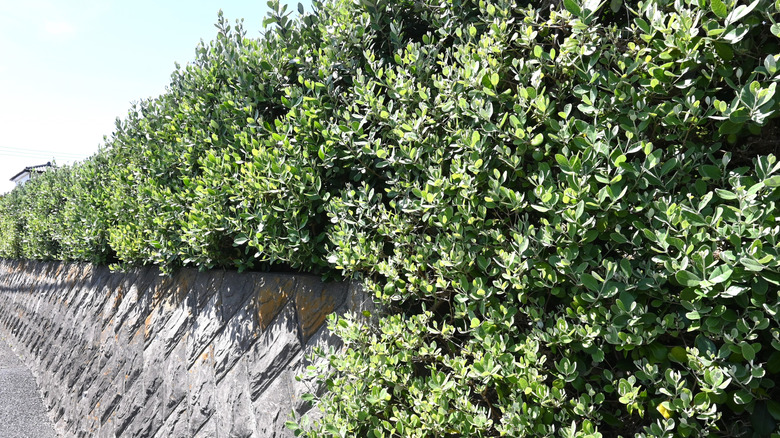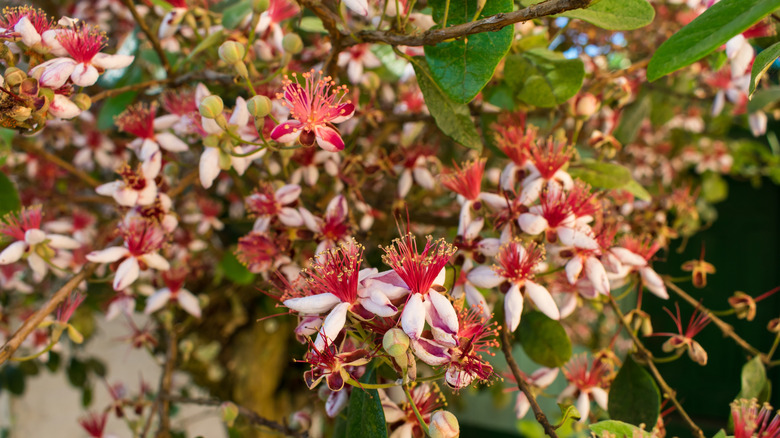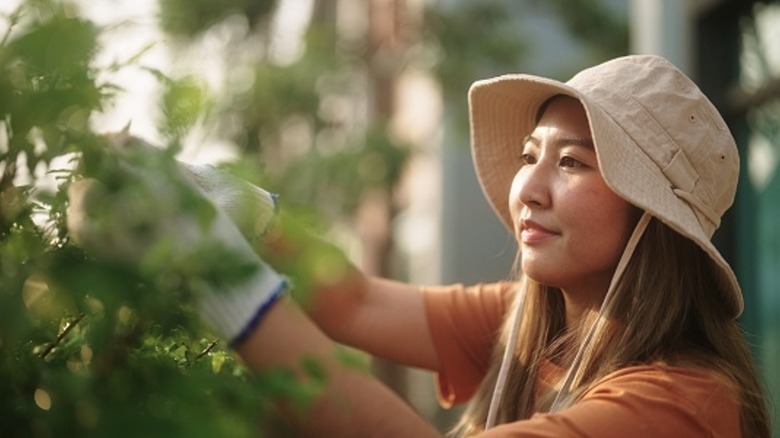Create Privacy In Your Backyard With A Fruit-Bearing Shrub That Birds Love
With a tantalizing name like pineapple guava, the tropical Acca sellowiana tree sounds appealing to humans as well as birds. And it is. Also called feijoa or guavasteen, this uncommon fruit tree native to South American native grows to about 10 to 15 feet high and can be trimmed into a dense-leaved hedge. Both the flowers and the fruit are prized by wildlife, birds in particular, although the fruit is not attractive to deer or insect pests. Blossoms in white, pink, and fuchsia decorate the gray-green evergreen foliage in spring, and yellow or green ovoid fruits ripen by the end of summer. Nectar from the pineapple guava blooms also lure in pollinators by the flock. In any form, this producer of tasty fruits provides a bit of seclusion while it brings all the birds to the yard.
Their dense foliage is an ideal thickness for a privacy hedge. In fact, pruning it regularly is recommended for the shrub to have a strong structure. Pineapple guava shrubs thrive in zones 8a to 11 and so far haven't shown any signs of becoming invasive. This plant can handle light freezes as well as high temps. It's also a drought-resistant plant that will thrive without much water once it's established. They also stand up well against airborne salt, making them ideal for seaside residents.
Set pineapple guava up for success
Pineapple guava trees hail from arid zones in central South America, so many types are well-suited for dry areas. If you live in a humid region along the coast, 'Mammoth', 'Moore', and the 'Edenvale' cultivars 'Late', 'Supreme', and 'Improved Coolidge' are top choices. For bi-colored foliage, try the cultivar 'Variegata' that boasts white and green variegated leaves.
There are a few self-pollinating cultivars like 'Coolidge', 'Nazemata', and 'Pineapple Gem' that are great sources of bird food without the need for a pollinating partner. However, if you're hedging up your pineapple guava, more than one plant placed side by side will give you better chances of a bumper crop. For those with postage-stamp yards, look into dwarf varieties, like 'Bambina', that only reach 3 to 4 feet high and wide.
Scout out a spot in your yard that gets full sun to partial shade; two to six hours of direct sunlight will do the trick. Pineapple guavas love well-drained soil and can also tolerate soil that's sandy, loamy, or slightly alkaline or acidic. If your soil is a bit acidic (a pH of 5.5 to 6.5), your plant will be happiest. Space your individual pineapple guava plants between 7 and 14 feet apart, or closer if you're hoping them to grow into a solid hedge. The perfect planting hole for your tree should match the root ball's depth and be three times as wide as its pot. Give your new plant a shot of extra nutrients by mixing the soil from the pot with an equal amount of aged compost or manure or a combination of the two.
Maintaining your pineapple guava shrub
In general, once your pineapple guava is well-established, it's a pretty easygoing shrub. Mature plants will perform well without extra water, but occasional watering can help plants produce more fruit. Regular, yet minimal, pruning is key to snipping up a reliable hedge. Pineapple guava tends towards slow growth. Subject your pineapple guava bushes to clippers in spring and late summer to keep growth under control by trimming them into hedges between 4 and 5 feet tall.
Pineapple guava plants can benefit from regular fertilizer applications. Either a conventional 10-10-10 or 8-3-9 will do in spray, liquid, or granular form. Give them a nutrient boost every 4 to 6 weeks from late winter until the fall. However, if you live an area where temperatures dip below freezing, don't fertilize after August, since this can spur new growth that will be vulnerable to frost damage. Give each shrub a 4- to 6-inch covering of mulch in both spring and summer, and make sure to leave a small gap between the mulch and the trunk to allow for air circulation.
Although they aren't particularly thirsty plants, regular, deep watering is essential during their first year. If you have light soil, water twice a week. For clay soils, one weekly watering is best. Soak the root system for 40 to 50 minutes. Once they reach maturity, at least one inch of water per week will bring the best results for growth and fruit yield.


